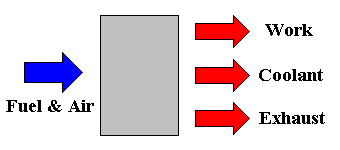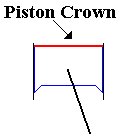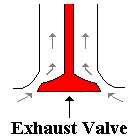 |
|
|
|
There is a need to keep the temperatures of two critical areas below material design limits. These areas are the piston crown and the exhaust valve.  
How do we determine engine heat transfer ? The calculation of engine heat transfer is difficult, due to the periodic air and fuel flow and the complex geometry of the engine. We rely primarily on experimental results. With recent advances in computational fluid dynamics, computation of engine heat transfer is becoming more possible. What are typical heat transfer rates in engines ? The majority of engines produced are automotive six cylinder engines, with about a 4" (100 mm) piston diameter (bore) and 4" (100mm) piston stroke , producing about 100 hp (75 kW). Since the heat transfer to the coolant and the heat convected from the exhaust are about equal to the power produced, the heat transfer to the coolant and to the exhaust will also be about 75 kW. For this typical automotive engine, the total cylinder volume or displacement is typically about 300 cubic inches (0.005 m3), and the total cylinder area is about 0.2 m3. Therefore the power density is about 75 kW/ 0.005 m3 or 15 MW/m3 of displacement. The heat transfer per unit cylinder area will be 75kW/0.2 m3 or 375 kW/m3. |
 |
 |